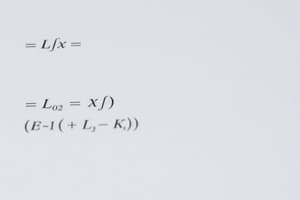Podcast
Questions and Answers
Relaciona los siguientes conceptos de cálculo con sus aplicaciones en la vida real:
Relaciona los siguientes conceptos de cálculo con sus aplicaciones en la vida real:
Derivadas = Determinar las tasas de cambio Integrales = Encontrar áreas bajo las curvas Límites = Concepto fundamental para cálculo Continuidad = Garantiza la solución de problemas matemáticos
Vincula los campos de aplicación con el uso de cálculo:
Vincula los campos de aplicación con el uso de cálculo:
Física = Modelar movimiento, fuerza y energía Ingeniería = Diseñar puentes y edificios, analizar circuitos eléctricos Economía = Modelar comportamiento del consumidor, inversión corporativa Medicina = Modelar crecimiento poblacional, dosis de medicamentos
Asocia las siguientes ramas de la ciencia con ejemplos de modelado utilizando cálculo:
Asocia las siguientes ramas de la ciencia con ejemplos de modelado utilizando cálculo:
Biología = Modelar crecimiento poblacional Ciencias ambientales = Modelar corrientes oceánicas, cambio climático Física = Expresar conceptos como velocidad, aceleración y fuerza Economía = Modelar dinámicas de mercado
Empareja los conceptos básicos del cálculo con sus funciones principales:
Empareja los conceptos básicos del cálculo con sus funciones principales:
Relaciona las siguientes áreas de aplicación con sus ejemplos específicos en cálculo:
Relaciona las siguientes áreas de aplicación con sus ejemplos específicos en cálculo:
Relaciona los siguientes conceptos matemáticos con su definición:
Relaciona los siguientes conceptos matemáticos con su definición:
Relaciona los siguientes elementos del cálculo con su propósito:
Relaciona los siguientes elementos del cálculo con su propósito:
Vincula las siguientes afirmaciones sobre cálculo con el concepto correcto:
Vincula las siguientes afirmaciones sobre cálculo con el concepto correcto:
Flashcards are hidden until you start studying
Study Notes
Exploring Mathematics: Calculus
Calculus, a branch of mathematics that traces its roots back to the 17th century, revolves around modeling change and finding expressions for it. It's a powerful tool that allows us to tackle a wide array of real-world problems with precision and clarity. Let's dive into the world of calculus to understand its fundamental ideas and applications.
Limits and Continuity
Calculus rests on the concept of limits, which involves approaching a function's output for increasingly smaller inputs. A function is considered continuous if its calculated limit matches its output at that specific input. For instance, the function (f(x) = \frac{1}{x}) is continuous everywhere except at (x = 0) because the limit as (x \to 0) does not exist due to division by zero.
Derivatives
Derivatives, or the rate of change of a function, are a fundamental concept in calculus. They allow us to determine an object's velocity or acceleration. The derivative of a function (f(x)), denoted as (f'(x)), represents the slope of the tangent line to the graph of (f(x)) at that specific point.
Mathematically, a derivative can be calculated using the limit expression (\lim\limits_{h\to 0}\frac{f(x+h)-f(x)}{h}). This expression represents the change in the function's output divided by the change in the input.
Integration
Integration, the opposite of differentiation, is the process of finding the area under a curve or the cumulative sum of a function's values. In other words, it answers questions like, "What is the total change in the function over a specific interval?"
The integral of a function (f(x)), denoted as (\int f(x)dx), can be calculated using antiderivatives. An antiderivative of a function is a function whose derivative is that function itself.
Applications of Calculus
Calculus has a broad range of applications, such as:
-
Physics: Calculus is used to model motion, force, and energy. The field of classical mechanics relies heavily on calculus to solve problems and express concepts like velocity, acceleration, and force.
-
Engineering: From designing bridges and buildings to analyzing electrical circuits, calculus is a fundamental tool for engineers.
-
Economics: Calculus is used to model consumer behavior, corporate investment, and market dynamics.
-
Biology and medicine: Calculus is used to model processes like population growth, diffusion, and drug dosage in pharmacology.
-
Environmental science: Calculus is used to model ocean currents, water pollution, and climate change.
Conclusion
Calculus is a powerful tool that allows us to tackle real-world problems with precision and clarity. With its roots in the concepts of limits and continuity, calculus introduces us to the ideas of derivatives and integration, allowing us to determine rates of change and find areas under curves. Calculus has applications in a wide array of fields, such as physics, engineering, economics, biology, and medicine. As a result, an understanding of calculus is essential for anyone seeking to delve deeper into the world of mathematics, the sciences, or engineering.
Studying That Suits You
Use AI to generate personalized quizzes and flashcards to suit your learning preferences.




